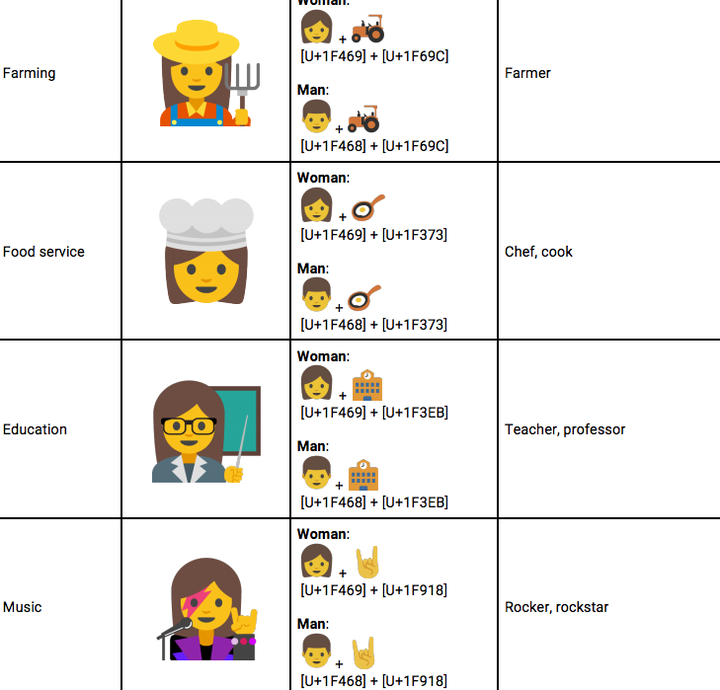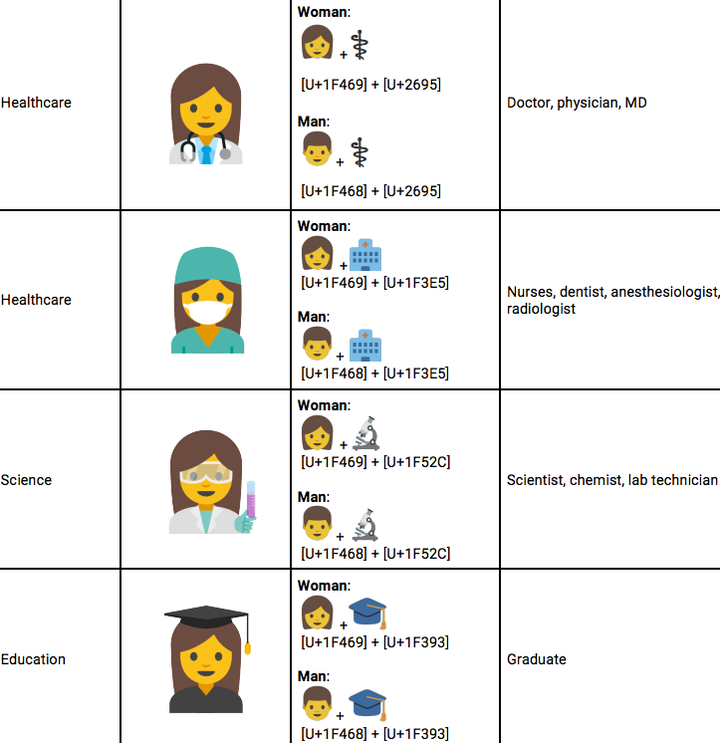
A handful of Google employees have developed a new set of emoji intended to better represent women — particularly in the workplace. And on Tuesday they submitted them to the Unicode Consortium, the Silicon Valley–based technical organization that, among other encoding projects, oversees the creation of new emoji.
Presented at The Unicode Consortium's quarterly meeting, the proposal aims to add 13 new emojis to the existing character set that "highlight the diversity of women’s careers."
"We believe this will empower young women (the heaviest emoji users), and better reflect the pivotal roles women play in the world," the proposal explains. The project is spearheaded by four Google employees — Rachel Been, Augustin Fonts, Nicole Bleuel, and Mark Davis, who is also co-founder and president of the Unicode Consortium — who hope the consortium "pursue[s] a path to standardize these emoji" by the end of 2016.
Since emojis’ explosion in 2011, Unicode has faced criticism over their lack of diversity. Last year the consortium officially incorporated a broader spectrum of skin tones and added inclusive glyphs like same-sex families.

But emojis’ evolution is far from over. Though linguists and even Unicode are reluctant to call it a language, emojis' popularity and global appeal make the once-obscure character set one of the most popular digital means of expression, which means it needs to evolve with its users and the times. It's complicated process that reflects many of the same complexities and politics of gender representation.
The Google team’s proposal, for example, notes that emoji should include all individuals, including those who don't identify as any particular gender. “We suggest decoupling the gender-neutral representation of emoji from this proposal. We would encourage other members of Unicode to join us in creating a system of emoji design that can accommodate a broader gender spectrum,” the proposal suggests.
The Google team’s proposal, then, is just one of many evolutionary steps — and this time the broader focus is on equal gender representation in the professional world. The proposed female emoji categories include: business, healthcare, science, education (graduate), technology, industry (factory/metallurgical worker, high-tech factory/assembly line worker, mechanic/repair person), farming, food service, education (professor), and music.

Emoji proposals are formal, and even the most frivolous emojis require detailed research and careful explanation before the consortium’s emoji subcommittee before they are approved. To narrow down the job categories for this proposal , the Google team combed over professional sectors that compose global GDP. Here's how the team described the process:
"To make our final selection, we looked at the primary, secondary, and tertiary categories that compose global GDP—Agriculture, Industry and Services—and further broke them down categorically based on global popularity, growth, and overall representation. We additionally added in concepts from popular media campaigns such as #likeagirl, global influencers, and the ongoing support to promote women in STEM.”
Since the professional women emoji proposal is in its earliest stages, its fate is uncertain. The submitted emoji could be severely altered, only partially accepted, or scrapped altogether. But as far as emoji proposals go, this one is high-profile, with backing from Google and Unicode’s president.
You can read the full proposal here.
from BuzzFeed - Tech https://www.buzzfeed.com/charliewarzel/google-is-proposing-a-new-set-of-emoji-to-better-represent-w?utm_term=4ldqpia
No comments:
Post a Comment